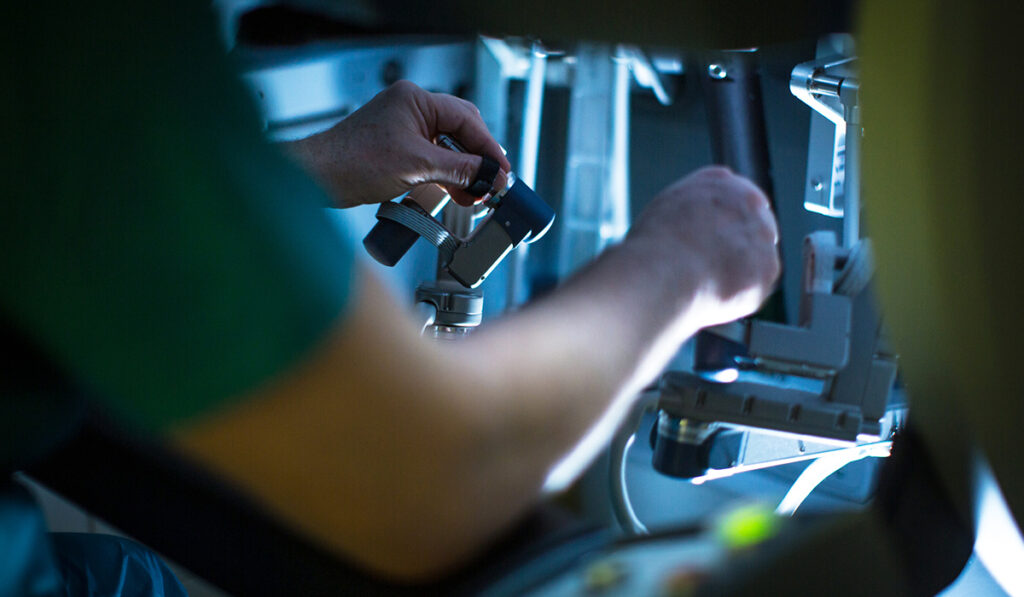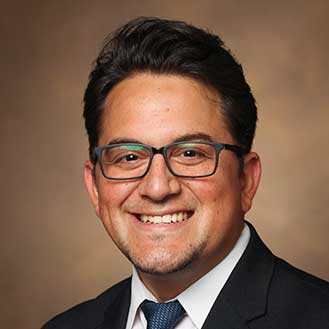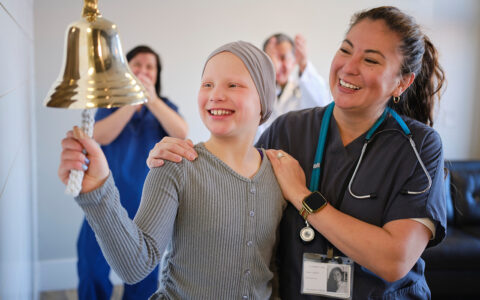Despite the intuitive pediatric advantage of maneuvering well in small spaces, robotics in children’s surgery has lagged adult volumes by a large margin.
Monroe Carell Jr. Children’s Hospital at Vanderbilt is leading the field in changing that. Collaborating with adult surgeons experienced in robotics, pediatric surgeons there have worked stepwise to build a robotics program capable of addressing urologic, colorectal, hernia, oncologic, and thoracic diseases in children.
Irving J. Zamora, M.D., M.P.H., with Vanderbilt medical student Marshall Wallace and colleagues, have prepared an abstract, Development of a Pediatric Robotic Surgery Program: Collaboration in Action, that describes the two-year-long initiative. The work, to be presented at the International Pediatric Endosurgery Group annual meeting, also focuses on training residents and fellows, as well as opening the door to colleagues around the world who want to learn from Monroe Carell’s experiences.
“Our hospital is on the same campus as the adult hospital, so we have had a special opportunity to benefit from collaborating with experienced robotics surgeons as we applied this technology in children over a tiered case difficulty progression,” Zamora said.
This progression considers both the complexity of the surgery and the size of the child who is eligible.
Wins for Patient and Surgeon
Zamora believes the time is ripe for pediatric surgeons to derive similar benefits as their adult colleagues, including wristed movements, enhanced 3D visualization, stable camera control and the ability to work safely in tight quarters with delicate tissues.
“Combining the da Vinci XI technology with [indocyanine green] firefly injections for illumination enables us to precisely locate critical structures, cancerous lesions and tissue perfusion during surgeries,” Zamora said. “We can clearly see the blood flow during resections and the vessels we need to avoid.”
He also points to reduced surgeon fatigue.
“This is also a huge factor for both the surgeon and the patient. Discomfort from wearing 3- to 5-pound headgear and leaning over a patient for hours has proven unsustainable over an entire career,” he said. “Sitting at a console takes the physical pressure off and improves ergonomics, allowing a more focused surgery, which benefits everyone.”
Monroe Carell’s Journey
In 2020, Monroe Carell acquired a new da Vinci XI, the next generation robot in the da Vinci series and one Zamora describes as much more facile for the surgeon and the staff, enabling more precise control and easier movement within the operating room.
Monroe Carell bioinformatics expert and pediatric surgeon, Gretchen Jackson, M.D., Ph.D., is vice president, scientific medical officer for Intuitive Surgical, Inc., the company that makes da Vinci systems.
“She serves as a bridge to optimize how well we understand and learn from the data acquired through the robot,” Zamora said.
Following training and institutional planning, the surgeons launched their case progression in 2021. In total, 28 robotic surgeries were performed in a 13-month period. This included a tiered-progression of case difficulty beginning with 18 cholecystectomies (21 total) followed by two colectomies, one anterior mesh rectopexy, one paraesophageal hernia repair, one heller myotomy, one distal pancreatectomy and one mediastinal mass resection.
“It’s all about patient selection. The cases have to lend themselves to this technology.”
Patient weights ranged from 53 to more than 300 pounds and ages from 10 to 19 years.
“It’s all about patient selection,” Zamora said. “Our urology colleagues are using robotics in babies as small as 10 kilos. But the cases have to lend themselves to this technology, and there is a stepwise process to get there.”
He says the graduated progression allowed trainees to become familiar with core robotic surgical techniques and technologies before advancing in surgical complexity.
“I can’t overstate the benefit of partnering with the surgeons who already had the robotics expertise on the adult side,” he said. “Because of that, I was able to go from zero to 30 surgeries in one year and grow the practice on the pediatric side very quickly.”
“I can’t overstate the benefit of partnering with the surgeons who already had the robotics expertise on the adult side.”
Beyond the Center’s Walls
“The next steps are to take care of our own house, training more of our own surgeons, residents and fellows,” Zamora said.
To do this, Zamora and colleagues are developing a formal curriculum while continuing to increase capacity in complex cases and those involving younger and smaller children.
“Then we definitely want to focus on our outcomes research, being able to determine how we’re doing through formal measurement, and utilize that data to help continue to improve the program going forward,” he said.
They also plan to work in partnership with other major children’s hospitals across the country that are implementing robotics in pediatrics.
“We pediatric surgeons who are using robotics are a small group but are slowly growing. We know each other and can all benefit from powering our research through collaboration,” he said.






